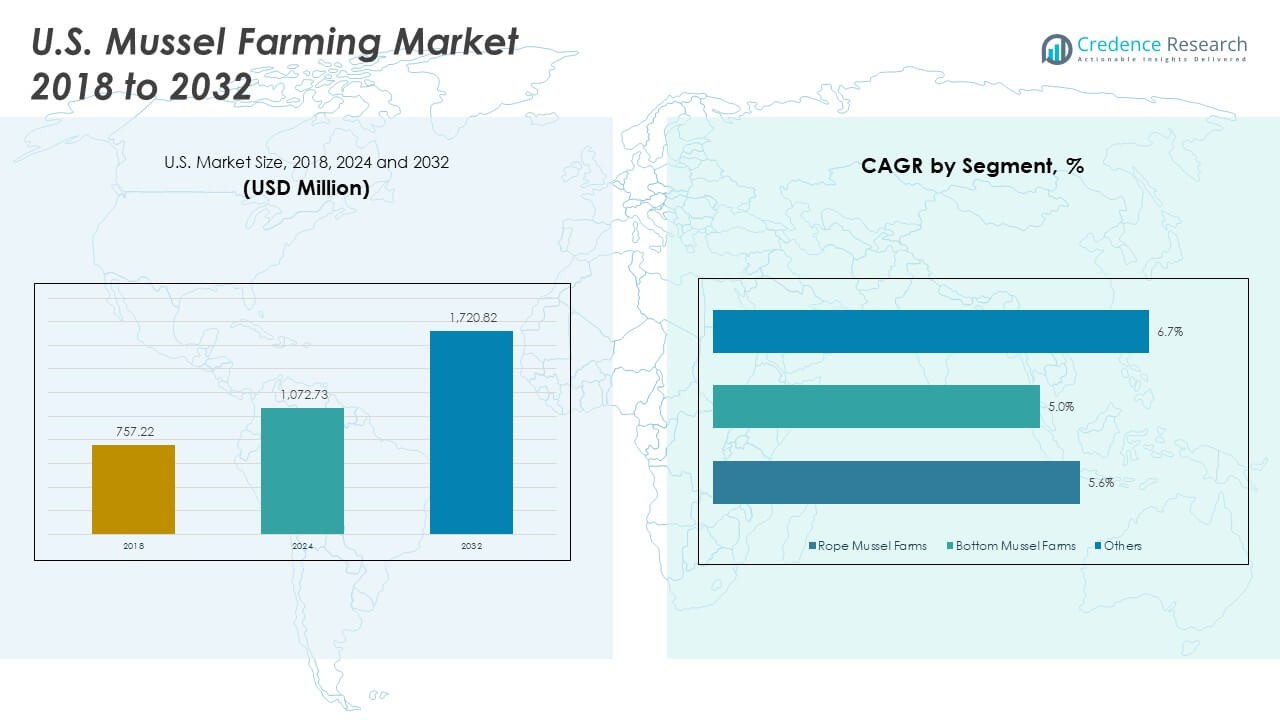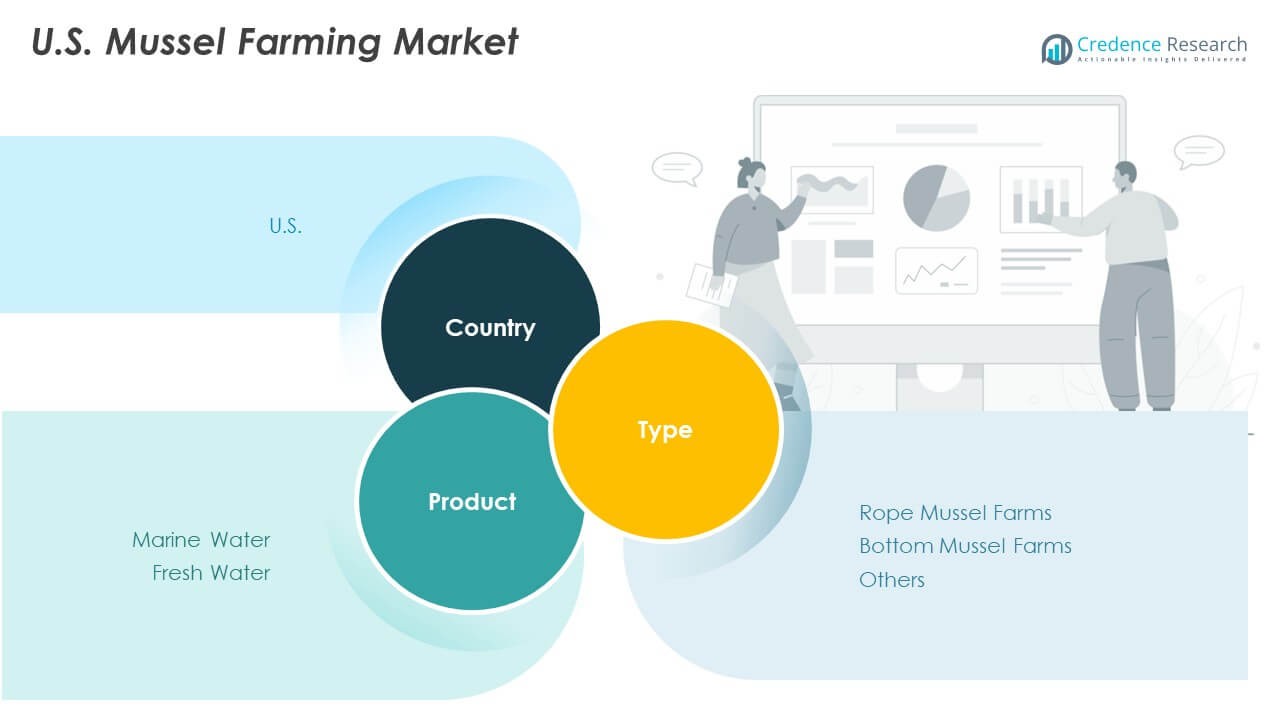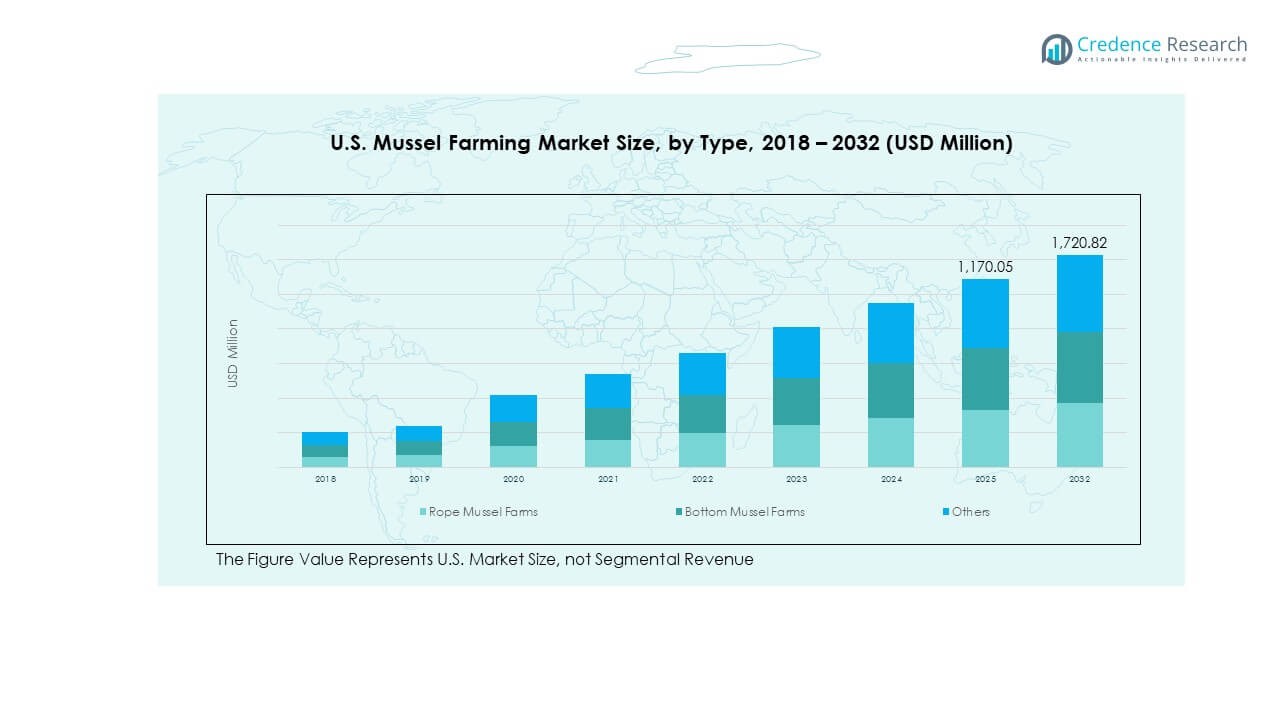Market Overview:
The U.S. Mussel Farming Market size was valued at USD 757.22 million in 2018 to USD 1,072.73 million in 2024 and is anticipated to reach USD 1,720.82 million by 2032, at a CAGR of 5.67% during the forecast period.
| REPORT ATTRIBUTE |
DETAILS |
| Historical Period |
2020-2023 |
| Base Year |
2024 |
| Forecast Period |
2025-2032 |
| U.S. Mussel Farming Market Size 2024 |
USD 1,072.73 Million |
| U.S. Mussel Farming Market, CAGR |
5.67% |
| U.S. Mussel Farming Market Size 2032 |
USD 1,720.82 Million |
Growth in the U.S. Mussel Farming Market is driven by increasing consumer demand for sustainable seafood, rising awareness of the nutritional benefits of mussels, and expanding aquaculture investments. The market benefits from the shift toward eco-friendly protein sources, supported by regulatory frameworks promoting sustainable farming practices. Technological advancements in aquaculture systems enhance production efficiency, while growing health-consciousness among consumers strengthens demand. Restaurants, retail outlets, and online platforms are further boosting accessibility, expanding the market’s reach across multiple consumer segments.
Regionally, the U.S. market is led by coastal states with strong aquaculture infrastructure, such as Maine, Washington, and California. These regions leverage favorable marine ecosystems and long-standing seafood cultures to sustain growth. Emerging opportunities are seen in southern states, where investments in aquaculture diversification are rising. The Northeast benefits from established supply chains, while the West Coast leads in innovation and sustainable practices. Regional growth patterns reflect both environmental advantages and supportive state-level initiatives.
Access crucial information at unmatched prices!
Request your sample report today & start making informed decisions powered by Credence Research Inc.!
Download Sample
Market Insights:
- The U.S. Mussel Farming Market size was valued at USD 757.22 million in 2018, projected at USD 1,072.73 million in 2024, and expected to reach USD 1,720.82 million by 2032, growing at a CAGR of 5.67%.
- Northeast holds 38% share, driven by established aquaculture infrastructure and strong seafood demand; West Coast accounts for 32%, supported by innovation and favorable ecosystems; Mid-Atlantic contributes 18%, benefiting from long-standing mussel farming traditions.
- The Southern U.S. is the fastest-growing region with 7% share, fueled by diversification in aquaculture practices and supportive state initiatives.
- Rope mussel farms dominate with 52% share, due to higher yields and suitability for large-scale production.
- Bottom mussel farms hold 36% share, supported by traditional practices and regional consumer preference, while others contribute 12%.

Market Drivers:
Rising Demand for Sustainable and Nutritious Protein Sources:
The U.S. Mussel Farming Market benefits from growing consumer preference for sustainable seafood options. Mussels are rich in proteins, omega-3 fatty acids, and essential minerals, making them a valuable part of balanced diets. Consumers are actively seeking low-carbon footprint foods, and mussels fit this requirement due to their natural filtration abilities. Health-conscious lifestyles are pushing demand in retail, foodservice, and online channels. Rising awareness about mussels as a superfood supports steady growth. It also helps diversify dietary protein sources away from conventional meat. The rising pressure to reduce greenhouse gas emissions in food production adds momentum. This shift ensures strong long-term growth prospects.
- For instance, Health-conscious lifestyles are increasing mussel demand across retail, foodservice, and online channels, with rising awareness highlighting mussels as a superfood that supports steady market growth.
Expanding Aquaculture Investments and Technological Advancements:
Aquaculture investments are increasing in key coastal states, helping improve production capacity and efficiency. The U.S. Mussel Farming Market gains from advancements in hatchery technology, improved rope systems, and bio-secure farming practices. These innovations reduce disease risks and optimize yields. Federal and state programs encourage aquaculture expansion, promoting infrastructure development in marine farming. Supportive funding schemes and collaborations with universities improve research and technical expertise. It benefits producers by lowering operational costs and enhancing sustainability. Investors are showing confidence in mussel farming’s long-term profitability. It strengthens the sector by creating a modern, technology-driven aquaculture ecosystem.
- For instance, Federal and state programs have increased infrastructure development support, while funding schemes and university collaborations elevate technical research and expertise.
Supportive Government Policies and Regulatory Frameworks:
Government agencies play a crucial role in boosting confidence in mussel farming practices. The U.S. Mussel Farming Market benefits from initiatives promoting responsible aquaculture development. Regulatory frameworks ensure environmental protection, food safety, and sustainable harvesting. Federal and state authorities simplify permitting processes, encouraging more farmers to enter the sector. Financial incentives and grants support new entrants and established players alike. These policies create favorable conditions for industry expansion. Public-private partnerships also help strengthen supply chains and export capacity. It creates long-term stability and fosters continuous growth in the industry.
Growing Presence of Foodservice and Retail Distribution Channels:
The role of restaurants, supermarkets, and online retail is expanding rapidly. The U.S. Mussel Farming Market sees strong growth through demand from gourmet dining and fast-casual outlets. Consumers are more willing to try mussel-based dishes in diverse cuisines, expanding awareness. Retail distribution ensures availability of packaged mussels with consistent quality standards. Online sales provide convenience and wider access to consumers across states. Marketing campaigns highlight mussels as eco-friendly and nutritious, building stronger consumer connections. Retailers and distributors support branding and quality control initiatives. It strengthens the presence of mussels in mainstream consumer diets nationwide.
Market Trends:
Integration of Mussel Farming with Renewable Energy Projects:
An important trend involves combining aquaculture with renewable energy installations. The U.S. Mussel Farming Market explores synergies with offshore wind farms to optimize space use. Farmers use shared marine zones for mussel cultivation and energy generation. This dual-use strategy improves efficiency and reduces environmental impact. Renewable integration attracts investment due to sustainability appeal. Companies pursue joint ventures to scale these combined models. It represents a forward-looking shift in resource utilization. The trend ensures alignment with broader clean energy goals.
- For instance, A notable trend is the integration of mussel farming with renewable energy projects, specifically offshore wind farms. This dual-use strategy optimizes space by combining marine zones for both mussel cultivation and energy generation, enhancing resource efficiency while minimizing environmental impact.
Development of Value-Added and Ready-to-Eat Mussel Products:
Producers are diversifying offerings with convenient mussel-based foods. The U.S. Mussel Farming Market increasingly emphasizes ready-to-cook and ready-to-eat formats. Flavored mussels, frozen packs, and vacuum-sealed options expand consumer access. Convenience-driven demand aligns with urban lifestyles seeking quick, healthy meals. Value-added products increase margins while reducing waste in distribution. Processed mussels also gain traction in export markets. It expands the appeal beyond traditional raw shellfish sales. The trend broadens market reach and enhances profitability.
- For instance, Producers are broadening product portfolios with value-added and convenient mussel food products. The market shows increasing emphasis on ready-to-cook and ready-to-eat options such as flavored mussels, frozen packs, and vacuum-sealed servings, catering to consumers’ demand for quick, healthy meals.
Adoption of Digital Monitoring and Traceability Systems:
Technological adoption is transforming aquaculture management. The U.S. Mussel Farming Market applies IoT sensors, AI tools, and blockchain solutions to improve efficiency. Farmers monitor water quality, salinity, and nutrient levels in real time. Digital systems reduce risks of contamination and disease outbreaks. Blockchain enhances supply chain transparency and food safety. Consumers gain confidence in traceable, responsibly sourced seafood. It creates operational advantages and builds stronger brand trust. Technology integration helps maintain competitive differentiation in a growing market.
Collaboration with Environmental and Conservation Groups:
Producers are forming partnerships with environmental organizations to highlight mussels’ ecological benefits. The U.S. Mussel Farming Market aligns with marine conservation efforts by showcasing natural water filtration. Collaborative projects focus on habitat restoration and marine biodiversity protection. These initiatives improve public perception of aquaculture. Conservation-backed branding supports stronger consumer loyalty. Industry stakeholders gain from enhanced reputation and compliance with ecological goals. It reinforces mussels as an environmentally sustainable seafood option. The trend adds resilience to the industry’s long-term positioning.
Market Challenges Analysis:
Environmental Vulnerability and Climate Change Pressures:
The U.S. Mussel Farming Market faces challenges from changing environmental conditions. Rising ocean temperatures, pollution, and acidification affect mussel growth and survival rates. These factors threaten the stability of supply chains. Farmers must adapt operations to address shifting ecological balances. Red tides and algal blooms create periodic losses in production. Climate risks also increase the cost of mitigation and insurance. It places additional burdens on small-scale producers with limited capital. The challenge underscores the need for continuous adaptation strategies.
Regulatory Hurdles and Market Fragmentation:
The market encounters delays from complex regulatory processes at federal and state levels. The U.S. Mussel Farming Market must navigate strict approval requirements for site development. These hurdles often slow expansion and discourage new entrants. Limited coordination between agencies complicates the aquaculture landscape. Fragmentation creates disparities in production standards across regions. Smaller farms face difficulty scaling operations due to compliance costs. It hampers competitiveness against international suppliers with simpler regulatory systems. Addressing these challenges requires streamlined frameworks and unified standards.

Market Opportunities:
Expansion into New Regional and Export Markets:
The U.S. Mussel Farming Market has opportunities to expand beyond established coastal hubs. Farmers in emerging southern states are exploring aquaculture diversification, creating new supply centers. Export markets in Asia and Europe offer strong demand for sustainable seafood. Branding U.S.-grown mussels as premium, traceable products enhances competitiveness abroad. Partnerships with distributors and logistics providers strengthen export reach. It creates pathways for producers to diversify revenue streams. Growing global seafood demand ensures sustained opportunities for expansion.
Innovation in Sustainable Farming and Consumer-Centric Products:
Opportunities lie in developing innovative, consumer-focused solutions. The U.S. Mussel Farming Market can capitalize on eco-friendly packaging, digital sales platforms, and sustainable farming technologies. Investments in hatchery innovations improve production resilience. Consumer-oriented product designs, such as flavored mussel kits, cater to modern lifestyles. Collaboration with chefs and nutrition experts enhances awareness campaigns. It supports both domestic and global demand for healthier seafood. Innovative practices strengthen long-term growth while aligning with sustainability goals.
Market Segmentation Analysis:
By Type
Rope mussel farms dominate the U.S. Mussel Farming Market with the largest share. This farming method ensures higher yields, efficient harvesting, and better adaptability to diverse marine conditions. Large producers prefer rope systems because they offer scalability and sustainability while reducing production risks. Bottom mussel farms continue to hold a strong position, sustained by long-standing practices and consumer loyalty in traditional markets. They are most effective in regions with favorable seabed conditions that naturally support mussel growth. The others category records a smaller share but represents innovation and localized practices. It creates opportunities for small-scale farmers and experimental aquaculture models.
- For instance, Bottom mussel farms maintain a strong market position through established practices and strong consumer loyalty in regions with seabed environments conducive to natural mussel growth. The smaller “others” category, while less dominant, embodies innovation and localized approaches, opening opportunities for small-scale and experimental aquaculture ventures.
By Product
Marine water mussel farming accounts for the majority share of the U.S. Mussel Farming Market. Favorable coastal ecosystems and nutrient-rich marine environments provide reliable conditions for large-scale farming. Marine cultivation supports strong domestic supply and export capacity, making it the backbone of production. Fresh water mussel farming contributes a smaller share but adds diversity to the sector. It serves inland markets and supports projects in regions with limited marine access. Freshwater production also complements ecological restoration and research-led initiatives. It demonstrates potential growth in controlled environments where sustainability and niche demand drive adoption.
- For instance, Freshwater mussel farming, though a smaller segment, adds market diversity by serving inland consumers and supporting ecological restoration and research projects. The growth potential in freshwater farming lies in controlled environments that drive sustainability and tap niche consumer demand.

Segmentation:
By Type
- Rope Mussel Farms
- Bottom Mussel Farms
- Others
By Product
By Country
Regional Analysis:
Northeast
The Northeast leads the U.S. Mussel Farming Market with a 38% share, supported by strong aquaculture traditions and robust supply chains. Coastal ecosystems in Maine and nearby states provide ideal conditions for large-scale mussel cultivation. Advanced infrastructure and access to distribution hubs allow efficient delivery to both domestic and export markets. Demand is strengthened by restaurants and retail channels in metropolitan areas with high seafood consumption. State-led initiatives encourage sustainable aquaculture and ensure long-term viability. It remains the backbone of mussel production nationwide.
West Coast
The West Coast holds a 32% share, driven by innovation and sustainability programs in Washington, Oregon, and California. Producers in this region invest in advanced aquaculture systems, enhancing yields and reducing environmental challenges. Proximity to Pacific export destinations strengthens competitiveness in international markets. Urban centers such as Seattle, San Francisco, and Los Angeles generate strong retail and foodservice demand. Regional players highlight eco-friendly branding to attract health-conscious consumers. It positions the West Coast as a hub for modern and scalable mussel farming.
Mid-Atlantic and South
The Mid-Atlantic accounts for an 18% share, with states like New Jersey and New York supporting traditional farming practices and consistent consumer demand. Proximity to dense population clusters sustains sales through restaurants and specialty retailers. This region benefits from a reputation for fresh, locally sourced seafood. The Southern U.S., though smaller at a 7% share, records the fastest growth in the market. Expansion is supported by aquaculture diversification, favorable policies, and increasing seafood consumption. It provides emerging opportunities that contribute to the sector’s long-term development.
Shape Your Report to Specific Countries or Regions & Enjoy 30% Off!
Key Player Analysis:
- Atlantic Aqua Farms
- American Mussel Harvesters, Inc.
- Andrews
- Penn Cove Shellfish
- Mussel King
- Blue Harvest Fisheries
- Pacific Seafood Group
- North Island Mussel Ltd
- Foveaux Seafood Ltd
- Prince Edward Aqua Farms
- Others
Competitive Analysis:
The U.S. Mussel Farming Market is moderately fragmented, with a mix of established companies and regional players. Atlantic Aqua Farms, American Mussel Harvesters, Penn Cove Shellfish, and Pacific Seafood Group are among the prominent firms shaping competition. These companies focus on sustainable farming practices, product innovation, and expanding distribution networks to strengthen their presence. It benefits from long-term contracts with restaurants, retail chains, and exporters. Smaller firms emphasize niche markets and local supply reliability. Competitive strategies involve investments in advanced aquaculture systems, partnerships with distributors, and branding efforts that highlight sustainability. The market continues to evolve as players adopt new technologies to meet rising demand.
Recent Developments:
- Penn Cove Shellfish faced a temporary harvest closure in July 2024 due to detection of paralytic shellfish poisoning biotoxins in blue mussels. This closure affected commercial harvesting for at least two weeks with ongoing testing to ensure safety before resuming operation. This is a recurring issue in the area due to biotoxin blooms and impacts supply to restaurants and businesses across the U.S. West Coast.
- Atlantic Aqua Farms has initiated an expansion project to renovate and modernize its shellfish processing and wet storage facility in Borden-Carleton. The renovation aims to increase production capacity, reduce manual labor, and cut water usage, with new production line installation expected by December 2024 and operations for the mussel stripping building beginning in May 2025. This upgrade will enhance the facility’s ability to process both mussels and oysters, maintaining employment levels with role shifts as needed.
Report Coverage:
The research report offers an in-depth analysis based on type (rope mussel farms, bottom mussel farms, others) and product (marine water, fresh water). It details leading market players, providing an overview of their business, product offerings, investments, revenue streams, and key applications. Additionally, the report includes insights into the competitive environment, SWOT analysis, current market trends, as well as the primary drivers and constraints. Furthermore, it discusses various factors that have driven market expansion in recent years. The report also explores market dynamics, regulatory scenarios, and technological advancements that are shaping the industry. It assesses the impact of external factors and global economic changes on market growth. Lastly, it provides strategic recommendations for new entrants and established companies to navigate the complexities of the market.
Future Outlook:
- Growing demand for sustainable protein sources will strengthen consumer adoption.
- Expanding aquaculture investments will enhance production efficiency and capacity.
- Rising integration with renewable energy projects will create new farming opportunities.
- Value-added products will expand retail and export prospects.
- Advancements in hatchery technologies will improve resilience and supply stability.
- Digital monitoring systems will increase transparency and traceability in operations.
- Strategic partnerships with foodservice chains will broaden distribution channels.
- Regulatory support will encourage sustainable farming practices and new entrants.
- Climate adaptation strategies will become central to long-term production planning.
- Consumer awareness campaigns will reinforce mussels as a healthy, eco-friendly choice.






